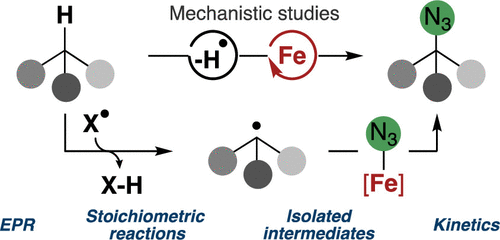Mechanistic Investigation of the Iron-Catalyzed Azidation of Alkyl C(sp3 )−H Bonds with Zhdankin’s λ3 Azidoiodane
J. Am. Chem. Soc., 2021, 143 (16184-16196)
View on publisher site
Abstract
An in-depth study of the mechanism of the azidation of C(sp3)–H bonds with Zhdankin's λ3-azidoiodane reagent catalyzed by iron(II)(pybox) complexes is reported. Previously, it was shown that tertiary and benzylic C(sp3)–H bonds of a range of complex molecules underwent highly site-selective azidation by reaction with a λ3-azidoiodane reagent and an iron(II)(pybox) catalyst under mild conditions. However, the mechanism of this reaction was unclear. Here, a series of mechanistic experiments are presented that reveal critical features responsible for the high selectivity and broad scope of this reaction. These experiments demonstrate the ability of the λ3-azidoiodane reagent to undergo I–N bond homolysis under mild conditions to form λ2-iodanyl and azidyl radicals that undergo highly site-selective and rate-limiting abstraction of a hydrogen atom from the substrate. The resultant alkyl radical then combines rapidly with a resting state iron(III)-azide complex, which is generated by the reaction of the λ3-azidoiodane with the iron(II)(pybox) complex, to form the C(sp3)–N3 bond. This mechanism is supported by the independent synthesis of well-defined iron complexes characterized by cyclic voltammetry, X-ray diffraction, and EPR spectroscopy, and by the reaction of the iron complexes with alkanes and the λ3-azidoiodane. Reaction monitoring and kinetic studies further reveal an unusual effect of the catalyst on the rate of formation of product and consumption of reactants and suggest a blueprint for the development of new processes leading to late-stage functionalization of C(sp3)–H bonds.
Read on publisher's site